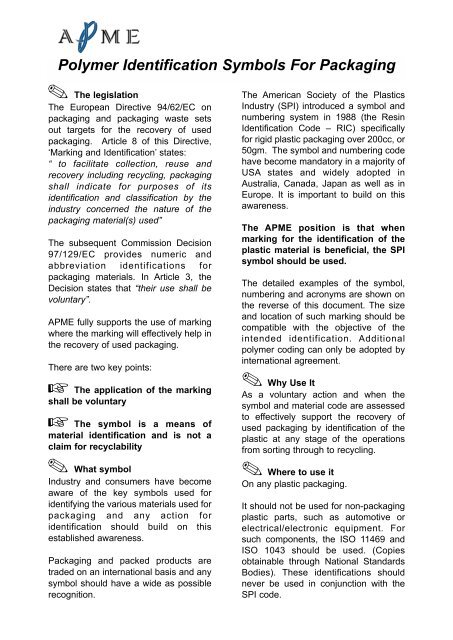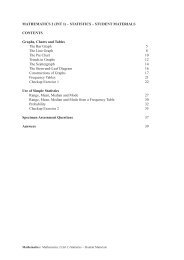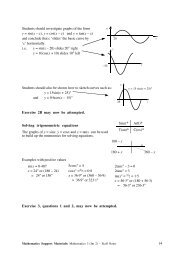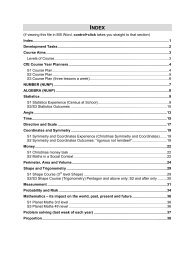Polymer Identification Symbols For Packaging
Polymer Identification Symbols For Packaging
Polymer Identification Symbols For Packaging
Create successful ePaper yourself
Turn your PDF publications into a flip-book with our unique Google optimized e-Paper software.
<strong>Polymer</strong> <strong>Identification</strong> <strong>Symbols</strong> <strong>For</strong> <strong>Packaging</strong><br />
✎<br />
The legislation<br />
The European Directive 94/62/EC on<br />
packaging and packaging waste sets<br />
out targets for the recovery of used<br />
packaging. Article 8 of this Directive,<br />
‘Marking and <strong>Identification</strong>’ states:<br />
“ to facilitate collection, reuse and<br />
recovery including recycling, packaging<br />
shall indicate for purposes of its<br />
identification and classification by the<br />
industry concerned the nature of the<br />
packaging material(s) used”<br />
The subsequent Commission Decision<br />
97/129/EC provides numeric and<br />
abbreviation identifications for<br />
packaging materials. In Article 3, the<br />
Decision states that “their use shall be<br />
voluntary”.<br />
APME fully supports the use of marking<br />
where the marking will effectively help in<br />
the recovery of used packaging.<br />
There are two key points:<br />
☞<br />
☞<br />
The application of the marking<br />
shall be voluntary<br />
The symbol is a means of<br />
material identification and is not a<br />
claim for recyclability<br />
✎<br />
What symbol<br />
Industry and consumers have become<br />
aware of the key symbols used for<br />
identifying the various materials used for<br />
packaging and any action for<br />
identification should build on this<br />
established awareness.<br />
<strong>Packaging</strong> and packed products are<br />
traded on an international basis and any<br />
symbol should have a wide as possible<br />
recognition.<br />
The American Society of the Plastics<br />
Industry (SPI) introduced a symbol and<br />
numbering system in 1988 (the Resin<br />
<strong>Identification</strong> Code – RIC) specifically<br />
for rigid plastic packaging over 200cc, or<br />
50gm. The symbol and numbering code<br />
have become mandatory in a majority of<br />
USA states and widely adopted in<br />
Australia, Canada, Japan as well as in<br />
Europe. It is important to build on this<br />
awareness.<br />
The APME position is that when<br />
marking for the identification of the<br />
plastic material is beneficial, the SPI<br />
symbol should be used.<br />
The detailed examples of the symbol,<br />
numbering and acronyms are shown on<br />
the reverse of this document. The size<br />
and location of such marking should be<br />
compatible with the objective of the<br />
intended identification. Additional<br />
polymer coding can only be adopted by<br />
international agreement.<br />
✎<br />
Why Use It<br />
As a voluntary action and when the<br />
symbol and material code are assessed<br />
to effectively support the recovery of<br />
used packaging by identification of the<br />
plastic at any stage of the operations<br />
from sorting through to recycling.<br />
✎<br />
Where to use it<br />
On any plastic packaging.<br />
It should not be used for non-packaging<br />
plastic parts, such as automotive or<br />
electrical/electronic equipment. <strong>For</strong><br />
such components, the ISO 11469 and<br />
ISO 1043 should be used. (Copies<br />
obtainable through National Standards<br />
Bodies). These identifications should<br />
never be used in conjunction with the<br />
SPI code.
<strong>Polymer</strong> Type<br />
CEN<br />
Recommendation<br />
CEN WI 261 070<br />
EU Commission<br />
Decision<br />
97/129/EC<br />
APME Position<br />
Polyethylene<br />
Terephthalate<br />
01<br />
PET<br />
1<br />
PET<br />
1<br />
PET<br />
High Density<br />
Polyethylene<br />
02<br />
PE-HD<br />
2<br />
HDPE<br />
2<br />
HDPE<br />
Polyvinyl Chloride<br />
03<br />
PVC<br />
3<br />
PVC<br />
3<br />
PVC<br />
Low density<br />
Polyethylene<br />
04<br />
PE-LD<br />
4<br />
LDPE<br />
4<br />
LDPE<br />
Polypropylene<br />
05<br />
PP<br />
5<br />
PP<br />
5<br />
PP<br />
Polystyrene<br />
06<br />
PS<br />
6<br />
PS<br />
6<br />
PS<br />
Unallocated<br />
references<br />
07-20<br />
7-19<br />
7-19<br />
ASSOCIATION OF PLASTICS MANUFACTURERS IN EUROPE (APME)<br />
APME’S TECHNICAL AND ENVIRONMENTAL CENTRE<br />
Avenue E. Van Nieuwenhuyse 4 Box 3 B-1160 Brussels<br />
Telephone (32-2) 676 17 50 Facsimile (32-2) 675 40 02 E-mail info.apme@apme.org Web site http://www.apme.org<br />
October 2001
















